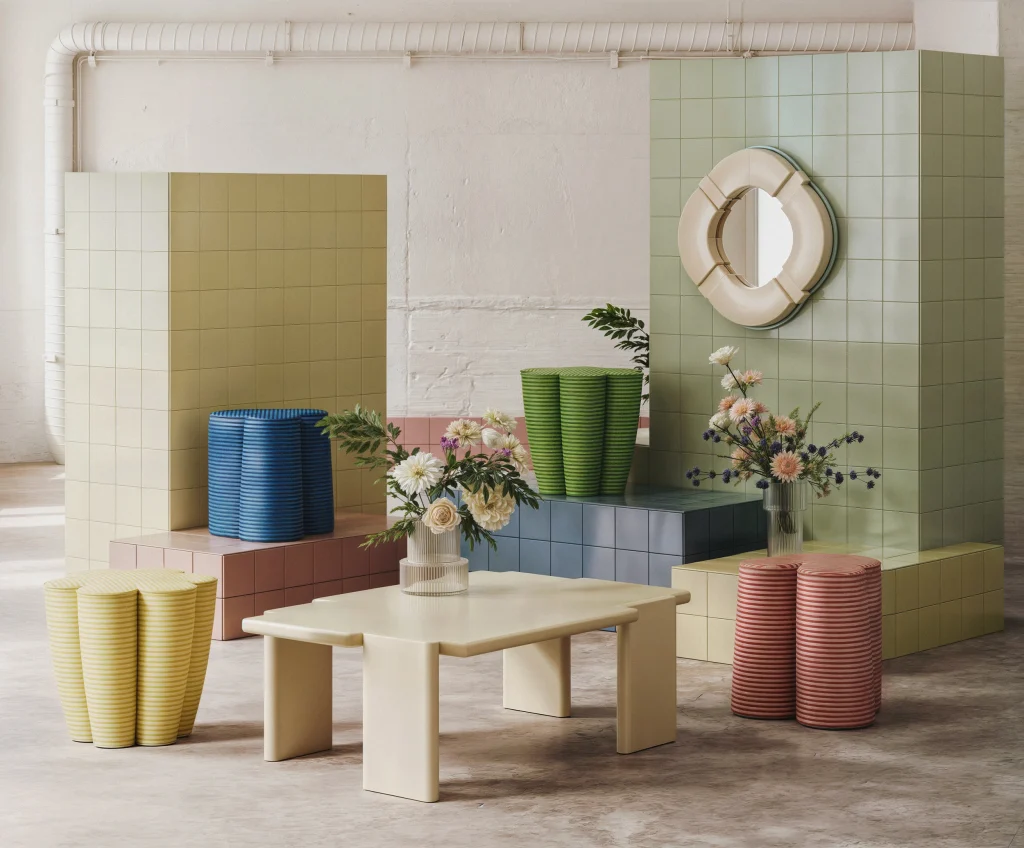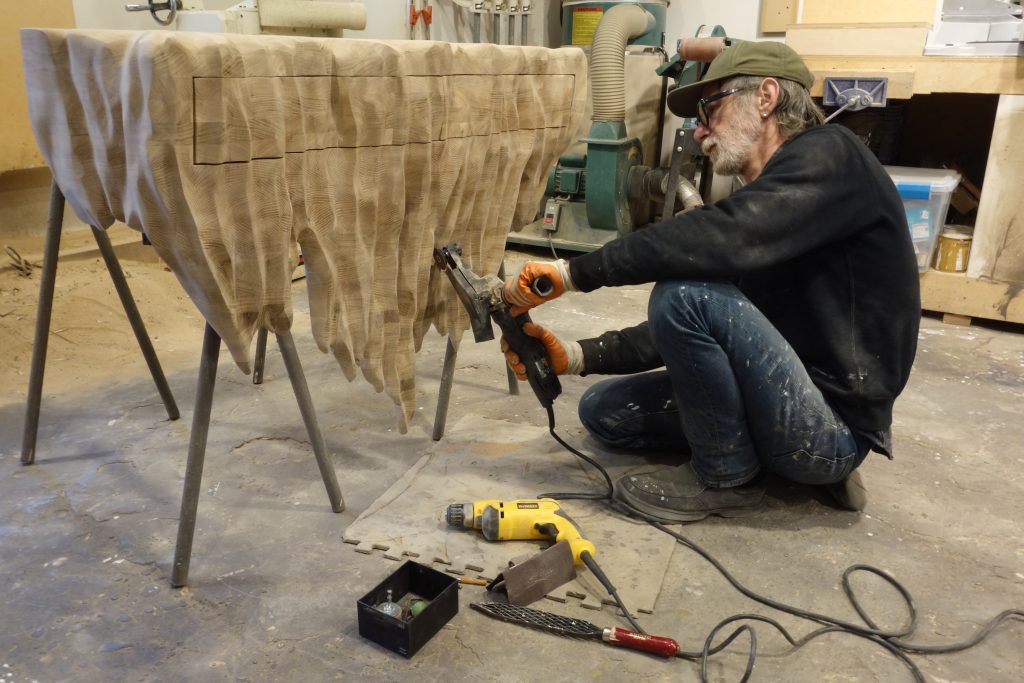
Erin Turkoglu: Exploring Craft & Process through Trial & Error
“I am often drawn to forms that showcase the material in interesting ways. Sometimes my work ends up cartoonish and sometimes it is brutalist, but I think it always has my design language in it. This is something I don’t consciously pursue, I think it’s just a side effect of my aesthetic values in practice.”
– Erin Turkoglu
View Erin Turkoglu ’s showroom, including “Puru” Lamp
Inspired by craft practices from around the world, designer Erin Turkoglu uses her multidisciplinary practice to investigate new craft processes. Clean lines, eye-catching colours, and intriguing textures are a mainstay in her ceramic work. In developing her craft, Turkoglu has had the opportunity to experience the commonalities and differences between three distinct design scenes: Istanbul, New York, and Helsinki. This mixture of design identities has shaped her creative approach, encouraging her to experiment and adapt to different craft languages. From the rich craft heritage of Istanbul to the fast-paced market of New York to the minimalistic stylings of Helsinki, the designer continues to develop her niche as she explores the boundaries of material and process.
Turkoglu’s cross-cultural influences have produced a poetic and detail-oriented design philosophy, visible in her hands-on approach to learning and in the refined craftsmanship of her pieces. Her explorative method reflects a desire to highlight the process itself and the possibilities of material. For example, the final form of “Puru” Lamp showcases the whimsical, soft gradient of the mouth-blown glass bulb, while the gentle curving bodies of “O-Jar” and “Silent Teapot” place emphasis on the elegant quality of porcelain. Process, as discussed previously by guest editor Charlotte Jul, is “a practitioner’s most important tool”, allowing experiments – both successful and failed – to develop a deep knowledge of one’s chosen craft. Erin Turkoglu ‘s approach to design does just this, showcasing the skills that she has developed between leading design centres and through the process of experimental trial and error. Her design identity is a unique amalgamation of where she has been and how she continues to adapt.
Your experience as a designer has led you from Istanbul to New York to Helsinki. How would you say these three distinct design scenes compare and/or differ?
I feel very lucky to have had the experience I had living in three distinct places around the world and to build myself as a designer with many different influences. My aesthetics, values, and the kind of design practice I do are the result of many experiences and design cultures I have been immersed in. [I think, in the end,] being a designer in all three places is more similar than different, but I felt the most difference in small details, such as how art and design are experienced, how fast trends move, and aesthetic values.
Istanbul is where I grew up, so it has a special place in my thinking process no doubt. My time in Istanbul as a designer was about constantly reinventing local tradition and pushing the boundaries of craft knowledge. There is also a constant source of inspiration around you, and an abundance of materials and crafts. You can go from one part of the city to the next and work with different craftspeople, people are so open to experimenting when it comes to making and crafting.
New York is where I completed my bachelor’s degree (at the Pratt Institute) and I constantly felt as if I was in the center of the art world there – going to the most impressive exhibitions and being part of a very international design scene was unforgettable. New York always seems to be looking for the next best thing, it has a very fast and exciting pace.
Helsinki is my current home. I decided to stay here after my MA studies (at Aalto University) mostly because of how much I feel at home in a relatively small and calm city. I also found my design language validated here, as I am quite detail-oriented and poetic in my work. My process of creation has become more slow-paced and fulfilling over the years.
I miss many things from Istanbul and New York, and even from my residency in Japan (at the Shigaraki Ceramic Culture Park with the support of the Finnish Institute in Japan), but Helsinki really feels like home at this point in my life.
In what way(s) has your experience in these scenes influenced your work?
I grew up in Istanbul, but I lived in the USA at different periods throughout my childhood as well. I think this ‘moving around’ allowed me to gain a special view of the world and a superpower of quick adaptation to new situations. [I think] this carries into my design process. I am constantly looking for new crafts, methods, and experiments to immerse myself into.
In New York, I gained my foundation as an artist and designer; in Istanbul, I validated my love for thinking with my hands/making; and in Helsinki, I found my design language and own way of working.
With reference to your multidisciplinary practice – including work with ceramic, glass, textile, and metal – where do you draw inspiration from when developing new pieces?
I draw inspiration from looking at my failures, material samples, experimenting with new ways of crafting: I think by doing. I could be inspired by architecture, the detail of a wall, a painting, or a photo, anything visual can be a source of inspiration. I like to look for potentials in things. I spend 90 percent of my time testing ideas and exploring potential rather than coming to a conclusion. When I find an interesting direction, then I start making objects. I like to follow the material, the form usually comes from the process of making itself. I am often drawn to forms that showcase the material in interesting ways. Sometimes my work ends up cartoonish and sometimes it is brutalist, but I think it always has my design language in it. This is something I don’t consciously pursue, I think it’s just a side effect of my aesthetic values in practice.


Material, colour, and form play an important role in your practice. In what ways have these aspects allowed you to experiment with different craft processes?
I am a little bit obsessed with colour. Colour mixing in various materials has been a fascination of mine, I even wrote my MA thesis about it! Colour has a lot of power in design. For me, it is never an afterthought, it is in fact sometimes the starting point. Every material has a unique relationship with colour. In ceramics, it is almost alchemic, where your final colour is dependent on your firing process, the chemicals used, and the temperature. In glass, colour becomes an optical illusion sometimes, you can play with refraction, transparency, and opacity. Colour, material, surface, and form are never separate, they all need to work together in my pieces and creating this harmony is very interesting to me.
“Puru” Lamp combines delicate, mouth-blown glass with a handmade ceramic base to create a piece which is both whimsical and functional. What was your approach when creating this piece?
I learned glass blowing during my studies at Aalto and one of the first things that grabbed my attention was how glass colour behaves. When opaque colors are used, you can really notice the gradient effect due to the bubble stretching out on the top, just like bubble gum. I couldn’t take my eyes off the test piece I made and I knew I needed to design a lamp from this material. I ended up walking around the studio with my pink glass bubble trying to find a base-form for it. In the end, I knew I wanted to reference the glass blowing process itself. The bubble is the glass blower’s breath in materialized, it is free-blown without a mold and the shape comes from how the material behaves. I decided on a simple cylindrical, kind of brutalist looking base as if the bubble is being blown right that moment.
I was trying to make a sculptural piece that is a tribute to glass-blowing. I also wanted it to be cartoon-like as it looks like a giant piece of bubble gum. I can see it fitting many different types of spaces.
The Puru Lamp is completely handmade: The glass part is made by the glass studio ‘Mafka & Alakoski’ and the ceramic part is made in my Helsinki studio.
Which craft processes do you hope to explore and experiment more with in 2021?
I am very much invested in ceramics this year. My Helsinki workshop has many new tools I am excited to use and I am also planning to do some larger works as well. I really enjoyed making lighting in 2020 and I am planning to continue on that as well.
Bio
Erin Turkoglu is an artist and designer working with subtlety of colour, material and an experimental crafting process. Her work is influenced by poetry, architecture and archeological archetypes as well as exploring the boundaries of material and process.


















Responses